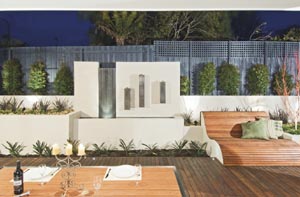
Story: Peter Nixon, MAILDM
Photos: Bruce Usher
It’s usual in residential design that the house sets the tone for any resulting garden. If the owner also feels this way, then the designer can really leverage the site with plants that show an architectural quality to make the combination of garden and house more convincing. This is what I was able to do with this lower north-side location in Sydney.
Having a patio level step out from the interior allows an easy indoor-outdoor flow for entertaining, despite the southern aspect of the house. Consequently, the owners make the most use of this tiled space after dusk in summer when the heat of the day has eased. From this sight line the challenge was how to make an interesting space from an “all seen in one sweep” viewpoint, anywhere across the elevated patio.
Being around one metre higher, the patio made the entire lower garden space more a “view to” rather than a “be in” objective. The sloping block might also have made withholding part of the view across its 15-metre width a less attractive option as the space I had to work with is a slightly more “landscape” than “portrait” shape.
To create interest yet avoid making two shallow and wide spaces across the block, I decided it was better to go the other way and create interest by punctuating the view with a centrally located reflection bath. Shallow enough to comply with council regulations it is also designed to pull a reflection of sky and the enclosing tree canopy down to the ground plane.
Satisfying to consider from the higher patio, the allure of water, with its glittering up-lit night appeal, makes the large urn at its far end a bold central feature. The water feature is big enough to be in scale and magnetic enough to draw viewers down to the lower level for a closer look at the garden as well. Voila! Interest made.
The reference points I drew from the house and used as design cues for suitable planting came from a modern cladding of textured tiles covering the walls, cedar-framed bi-folds and a large and light-coloured neutral patio tile. As a neutral foil, this meant the planting could be as loud as possible to “read” in contrast, as long as the surrounding fence was concealed, in the process giving enclosure for the bath and simultaneously obstructed rear neighbouring sight lines.
This also has the effect of lifting the eye up and out of an otherwise lower level and making the garden look connected to foliage on the other side of the fence line in a certain fence-free, more unlimited way.
Unifying the silvery freshness of the patio are two white metal wall sculptures with a palm motif embossed into the presenting sides. Light emitting diodes (LEDs) up-light these and in summer make entertaining on balmy nights, with the charm of near-still candle light from the dining table, an added touch of the tropics.
On the softscape side, I was determined to design this garden to flourish without irrigation. This is something that can be achieved by using durable and more interesting plants that are in climatic tune with the growing conditions they are destined for, making additional water unnecessary.
To reconcile the much greater height of the house with a much lower garden level, and in combination with existing Bangalow palms (Archontophoenix cunninghamiana) on the eastern boundary, I used an Abyssinian banana (Ensetes ventricosum), its prominent red mid-rib setting the scene for more red highlights.
In the shelter of the far south-western corner there are 1.5-metre-high clumps of pillar box red, pine cone-shaped bracts of spiral ginger (Costus comosus ‘Red Tower’), featuring yellow culinary flower “candles” that often find their way into the salad bowl for their zesty citrus flavour. Beneath the eastern Bangalow palms, tall, sun-tolerant cordylines (Cordyline negra), maturing at three metres, also colour with red-flushed foliage during summer.
Against so much lush green abundance, these glamorous red touches make a strong connection with a double-sided fibreglass pot that stands centrally on the patio as part of the design. With its heavily textured candle wax pattern and its opaque translucence, it “lights up” when the sun strikes it, lending a welcome finishing touch to this little piece of paradise among the frost-free beachside suburbs of Sydney.
About the author: Peter Nixon is the Director of Paradisus Garden Design and the founder of the Plant Growers Network.










